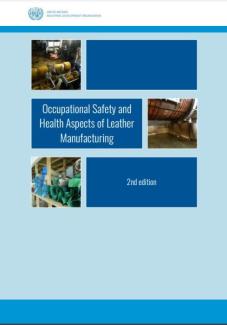Occupational Safety and Health Aspects of Leather Manufacture guideline released
The wide range of chemicals, machinery, equipment and processes used in the tanning industry can pose many occupational hazards and high risks to workers, especially in countries with weak law enforcement. Many tanneries fail to adopt proper preventive and protective measures to improve Occupational Safety and Health (OSH) standards, consequently putting their employees at risk. It has been demonstrated that overall safety standards can improve at little or no cost – all it takes is a little effort and good will.
“Safe and healthy work is a fundamental human right, but the new estimates of the costs of poor non-existent OSH measures show that the economic case for OSH has never been stronger” said Christa Sedlachek, Director of EU-OSHA. In this context, UNIDO released the second edition of the guideline on Occupational Safety and Health Aspects of Leather Manufacture, which is a thoroughly revised and expanded version of UNIDO paper published in 1999. This manual has been primarily prepared for use by tanners and tannery supervisors. It has been designed to provide guidance and ideas on how to improve the occupational safety and health standards at work in tanneries and effluent treatment plants by presenting the sources of hazards in a tannery and pointing out simple measures, in a practical and easily understandable manner, for ready implementation on-site.
On the whole, the general intention of UNIDO is to present and promote the concept of leather as a sustainable (as long as there is livestock to produce meat and milk) and safe material. To be classified as safe, it has to be:
- Safe for operators and a safe working environment (OSH)
- Safe for communities and ultimate users (all emissions treated and considered safe)
- Safe for consumers - finally, a tanner (producer) also has to design the leathers in a way that will facilitate its handling and disposal at the end of life. This includes avoiding the use of restricted substances and chemicals which may be harmful to a user and/or to anyone else.
Therefore, occupational safety and health aspects should be understood as an integral part of leather manufacturing.
The guideline is available here.
For further information contact Ivan Kral (I.Kral [at] unido.org (I[dot]Kral[at]unido[dot]org))

